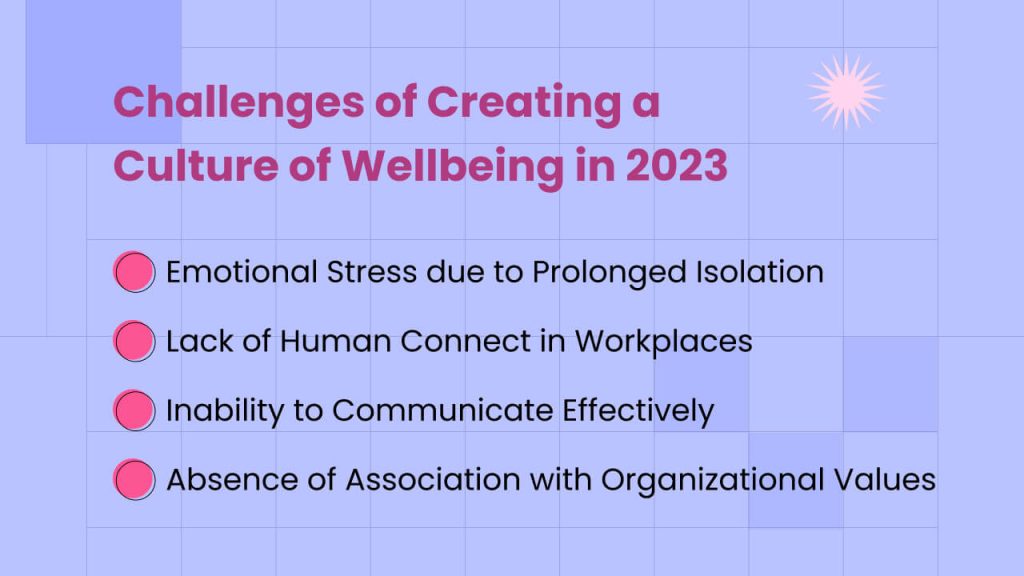Currently, the average adult spends one-third of their life at work. Consequently, organizational culture plays a significant role in promoting (or impeding) employee wellbeing as well as their overall quality of life.
Read on for our quick and easy-to-implement guide for a positive, wellbeing-centric culture.
What is a Positive Company Culture?
Organizational culture is the implicit social structure. within an institution. It influences the attitudes and actions of both employees and customers. Culture can unleash enormous amounts of energy towards a shared goal.

Employees who work for organizations with a robust, positive culture are more likely to:
- Be likely to be enthused by the company’s mission and purpose.
- They feel well-treated, acknowledged, and valued by their peers
- Experience reduced tension and increased engagement.
- Feel psychologically secure and liberated enough at work, to just be themselves.
- Stay more loyal and less inclined to exit.
There are numerous ways to establish culture (e.g., leadership). But a significant component of a positive company culture is the extent to which the organization values and promotes the well-being of its employees.
What is a Culture of Wellbeing?
A culture of wellbeing focuses on the ways in which employees’ health (both physical and mental) and satisfaction are influenced by their work, whether it’s by activities, colleagues, or the workplace environment.
It encompasses physical elements such as back pain from prolonged periods of sitting on their desks as well as mental aspects like burnout and depression. A company culture that embeds wellbeing has four tenets:
1. Greater participation in wellness initiatives
It builds confidence and encourages eager and avid participation. The culture demonstrates to the employees that the wellness initiative is in their long term interests.
2. Support from peers
Getting healthier by yourself is challenging. Supportive cultures promote healthy lifestyles and foster collaboration, and both of these contribute to improved mental health.
3. Support from Leadership
Leaders have a significant impact on the mental health of their employees . Wellbeing-centered workplaces motivate and incentivize leaders to prioritize employee wellbeing.
4. More engagement and productivity
Increased employee well-being leads to increased employee engagement, which could also result in improved bottom-line organizational outcomes by almost any metric or index of analysis.
What are the Challenges to Creating a Culture of Wellbeing in 2023?
The COVID-19 pandemic has altered how businesses operate. Working from home appears to have significant advantages, including greater flexibility and the elimination of commute times. But perhaps we miss watercooler conversations more than we understand.
Since the transition to remote work, employees have reported increased anxiety, unhappiness, trouble connecting, and diminished well-being. As their work and domestic lives converge, many are also experiencing difficulties with holistic wellbeing.

For many employees, there is still a stigma associated with discussing mental health issues openly (a major reason to look for wellbeing support). Moreover, organizations frequently miscommunicate the benefits of their wellness programmes to the individuals who require them. Sometimes, employees are distrustful and dismissive about anything that feels a bit like a sales pitch.
How to Embed Wellbeing into Your Company Culture?
5 Steps
To create a culture of wellbeing, organizations need to:
1. Create a Culture of Positive Leadership
The future leaders must hinge on how they look after their employees and promote their well-being. They must be passionate about supporting employee wellness, as opposed to viewing it as an impediment to achieving their goals. Via training and resources, businesses can reorient managers to become effective and well-being-focused leaders.
2. Encourage and actively make room for workplace socialization
Socialization in the workplace can serve as the cornerstone for robust peer support, which fosters happier workers and healthier lifestyles. Employers should provide time for employees to congregate and socialize in lunch or break rooms, or in a centralized area for physical activity. Clubs, team challenges, and group activities improve the workplace environment.
3. Insist on clarity
Employees experience less anxiety when they are aware of what is expected of them and, in particular, where, and how they will be completing their assigned tasks. Line supervisors must promote well-being by not only monitoring for indicators of distress, but also avoiding contributing to it themselves.
4. Make it easier to stay healthy physically
Physical and mental health are inextricably linked. Employees can be encouraged to bicycle or commute by foot. Offering benefits which make it simple to incorporate physical activity and healthy eating into one‘s daily routines are excellent ways to motivate your team to maintain their physical health.
5. Gather and act on wellbeing data
Ask employees about their expectations. This can be easily accomplished through a brief survey or an online focus group. Different generations, races, genders, and sexual orientations have different well-being needs, so make sure you include a representative sample.
Conclusion
Essentially, a culture of employee wellness must address physical, psychological, fiscal, and social health, as well as stress triggers at work. If, for example, employees are discreetly struggling with financial troubles, they will not be productive and focused at work. If organizations recognise and address these systemic problems, it is more likely that wellbeing will become part of the core fabric of the organization.
1